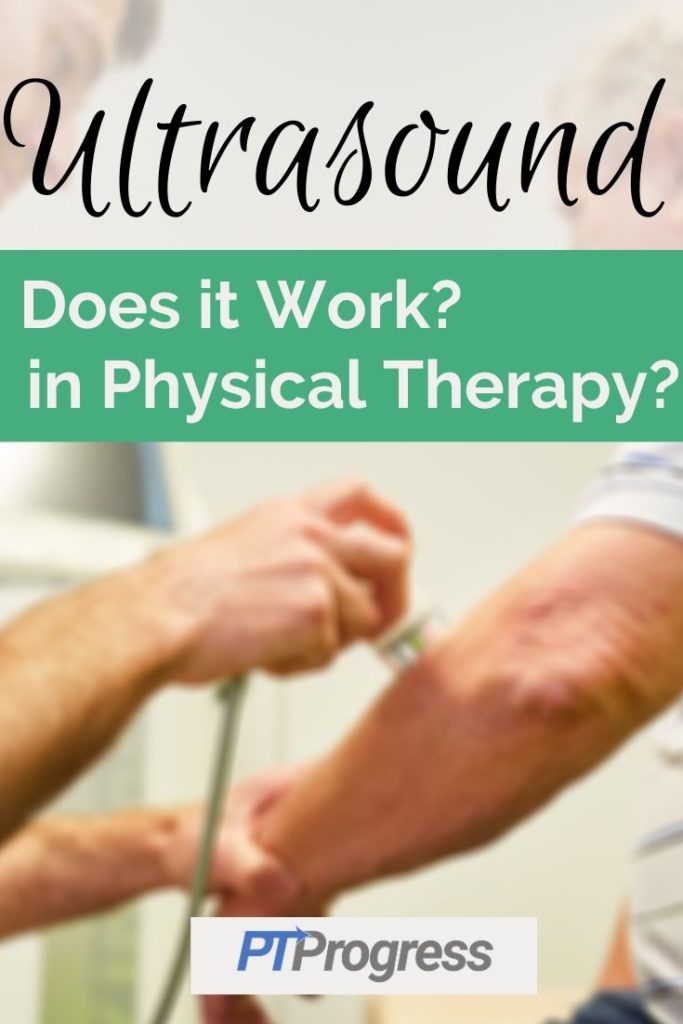
Ultrasound has been used in physical therapy as a treatment to relieve aches and pains for nearly 70 years. But does ultrasound work? Is physical therapy ultrasound a waste of time or a proven treatment? In this article, you’ll learn how ultrasound works and whether or not it is effective.
Physical therapy has certainly changed over the years. Long before I was ever practicing, going to physical therapy meant massage, heat, ice, iontophoresis, electrical stimulation, and ultrasound….passive modalities.
Over the years the focus of physical therapy treatments has shifted away from passive treatments and toward more active interventions (ie. strengthening, balance training, functional mobility training, etc). For most people, except perhaps some of our less motivated patients, this shift is regarded as a positive change in the profession; being both a more effective form of treatment and more empowering to patients.
What does that mean for the use of ultrasound in today’s outpatient clinics? It is still one of the most widely used modalities in the world…is there a place for ultrasound in our treatment plans in this day and age? Let’s take a look.
What is Ultrasound and How Does it Work?
To establish exactly what we’re talking about, let’s first briefly discuss what ultrasound is and how it works.
Put simply, ultrasound is mechanical sound waves above the level of human hearing.
When the alternating compressions and rarefactions are absorbed by the soft-tissue in the body, the mechanical energy of the sound waves (vibrations) is proposed to result in increased tissue temperature, increased localized blood flow, increased tissue extensibility, and accelerated metabolism through increased cellular permeability.
However, these effects depend on the frequency, intensity, and duty cycle at which the ultrasound is set.
Frequency
The frequency of therapeutic ultrasound can be set from 1MHz to 3MHz, depending on the structures you wish to target. At 1 MHz, the ultrasonic waves penetrate deeper into the soft-tissue; while at 3MHz the effects are limited to more superficial structures.
Intensity
The intensity is the amount of power per unit area; usually expressed in W/cm2. Typically, intensity is set somewhere between 0.5 W/cm2 and 2.0 W/cm2. Intensity must be set with frequency in mind, as the thermal effect of the chosen intensity will depend on the frequency; with greater thermal changes noted when 3MHz is used.
As you can see from how intensity is expressed (W/cm2), a smaller ultrasound head and a smaller treatment area means a smaller cross-sectional area (cm2) and thus a higher intensity…or more watts per cm2.
Duty Cycle
Duty cycle is the total amount of treatment time which the ultrasound is actually ON for. This is where pulsed vs. continuous ultrasound comes into play. By setting the machine to, say 50%, you’re creating parameters in which the ultrasound will be alternatingly turned on and off, with a total “on time” accounting for 50% of the total treatment time. Continuous (100% duty cycle) ultrasound is what you want if you’re seeking thermal effects. Because pulsed ultrasound interrupts the soundwave generation, the intensity output overtime is lower; resulting in non-thermal effects.
Thermal v. Non-Thermal
Assuming for a moment that ultrasound is a well proven intervention for the patient or condition you have in mind, how do you know if you should be using ultrasound for thermal or non-thermal effects? That part is fairly straightforward. Ask yourself if this is something you would use other heating agents for…the answer is usually the same.
While something like a moist hot pack has a superficial penetration of 1-2cm, with the correct parameters set, therapeutic ultrasound has the capacity for up to 5cm of penetration. But remember, thermal effects depend on frequency and intensity. You would have to use the ultrasound for longer and at a higher intensity when set at a frequency of 1MHz (deeper penetration) to achieve the same thermal effect you get at a frequency of 3MHz. For example, to elicit an increase of 4℃ at a duty cycle of 100%, you would need 14 minutes at 1.5 W/cm2 while at 1MHz, but only 7 minutes at 1.0W/cm2 if set at 3MHz.
If you’re like me and you look at all those numbers and go cross-eyed, here’s the gist of it. While the frequency should ultimately be set based on the desired depth of penetration, superficial (3MHz) is more efficient at creating a thermal effect.
Ultrasound used for thermal effects is best reserved for when the goal of your treatment is to decrease tissue spasticity, increase elasticity of soft-tissue/collagen, or to work on trigger points. Parameters resulting in thermal effects should NOT be used for acute injuries or inflammation. It should also be noted that tendon is a better conductor of heat and therefore requires less intensity and less time to achieve the same thermal effects.
Summarized even further:
- For acute injuries you want the non-thermal effects of pulsed ultrasound.
- When a thermal effect is desired use a higher duty cycle, or continuous ultrasound with greater intensity and duration when targeting deeper tissues (1MHz).
To Use or Not to Use…That is the Question
All of the information above sounds great…in theory. However, I’m assuming you didn’t click on this article because you’re just fascinated with how changing ultrasound parameters should theoretically effect a patient’s tissue. So let’s answer the most important question: Does the use of ultrasound result in subjective and objective improvements in your patients?
Articles exist out there both for and against the use of ultrasound for many different conditions, so let’s focus on the strongest evidence available, systematic reviews and the current APTA Clinical Practice Guidelines (CPGs).
Reading systematic reviews and CPG’s in your free time is about as much fun as a poke in the eye. Luckily for you, I’ve taken the liberty of doing most of the leg work. When I have a question about the effectiveness of a certain intervention I start with systematic reviews, move on to CPG’s if it pertains to a specific body part or type of injury, and will finally consult individual studies as needed. I would encourage you to do the same if you have a specific question that is not addressed below.
Systematic Reviews on Ultrasound
A systematic review of the effectiveness of ultrasound on musculoskeletal disorders done in 1999 by Van Der Windt, et al found that the evidence “did not support the existence of clinically important or statistically significant differences in favour of ultrasound therapy”. Additionally, in 2001 35 RCT’s on the effectiveness of ultrasound were reviewed and again found little to no evidence that ultrasound was any more effective than placebo. To that you may say, “Wow, systematic reviews from 1999 and 2001? Let me put down my Dunkaroos and read those as soon as I return my rented copy of Toy Story to Blockbuster”. Fair point. Let’s take a look at a more recent review.
In 2019 Aiyer, et al performed a systematic review of the use of ultrasound for the management of chronic joint pain, and although they found some evidence to support the therapeutic effect on knee pain (with knee OA being the most studied condition), there was little evidence to suggest any functional improvement for hip, knee, or shoulder disorders. Moreover, there seems to be a lack of consensus on the appropriate delivery method (pulsed v. continuous).
Clinical Practice Guidelines on Ultrasound
Let’s keep this part short and sweet. I’ll limit this to a few of the conditions most commonly treated with ultrasound.
| Neck Pain w/ Mobility Deficits | Pulsed ultrasound is beneficial based on weak evidence at reducing pain in the short-term, but was inferior to mobilization |
| Neck Pain w/ Movement Coordination Impairments | Pulsed US was found to be not beneficial based on weak evidence when compared to a control group |
| Adhesive Capsulitis | Use of US for 10 min at 3MHz and 1.5W/cm2 is beneficial based on weak evidence, as this group had statistically significant ROM improvements over the control group immediately and at 3mo follow up |
| Carpal Tunnel Syndrome | Conflicting evidence exists regarding non-thermal US. Thermal US was found to be not beneficial based on weak evidence |
| Hip Osteoarthritis | Through 10 treatments over 2 weeks with 1MHz and 1W/cm2 for 5 minutes, US was shown to be beneficial based on moderate evidence when used in addition to exercise and hot packs |
| Heel Pain/Plantar Fasciitis | Use of US was shown to not be beneficial based on weak evidence |
| Ankle Sprains | Use of US is discouraged as it is shown to be not beneficial based on STRONG evidence |
Summary
What I hope strikes you about the evidence listed above is that whether it is against or in favor of ultrasound, the vast majority of the evidence is weak. Despite ultrasound being a staple of physical therapy since the 1950’s, there is a shocking lack of quality research.
Of the weak evidence that actually exists, most does not support the use of ultrasound for treatment of musculoskeletal conditions. So, as I previously stated, for many conditions you’re probably best served by finding recent studies that pertain to your patient in particular, and evaluating the quality of the research for yourself.
As it stands, this is the way I see it…at best, ultrasound is a moderately effective modality in treating a select few conditions if the parameters are set just right. At worst, since the potential risks and side effects are minimal, it is a waste of time for both you and your patient. Time that could be better spent delivering more skilled and more effective care.

This article was written by Dan Murphy DPT, OCS. Dan graduated from Washington University in St. Louis in 2016 and lives just outside of Chicago with his wife and 2 year old son; though he and his wife are expecting a daughter in a few months! He enjoys playing board games and any outdoor activities with friends and family.
Sources:
Chan AK, Myrer JW, Meason GJ, and Draper DO. Temperature changes in human patellar tendon in response to therapeutic ultrasound. J Ath Train. 1998; 33(2): 130-135.
Morishita K, Karasuno H, Yokoi Y, et al. Effects of therapeutic ultrasound on range of motion and stretch pain. J Phys Ther Sci. 2014;26(5):711‐715. doi:10.1589/jpts.26.711
Van der windt DA, Van der heijden GJ, Van den berg SG, Ter riet G, De winter AF, Bouter LM. Ultrasound therapy for musculoskeletal disorders: a systematic review. Pain. 1999;81(3):257-71.
Robertson VJ, Baker KG. A review of therapeutic ultrasound: effectiveness studies. Phys Ther. 2001;81(7):1339-50.
Aiyer R, Noori SA, Chang KV, et al. Therapeutic Ultrasound for Chronic Pain Management in Joints: A Systematic Review. Pain Med. 2019


Great article! Question- If penetration is 5 cm would it be harmful on a pacemaker if you were using at left cervical extensors- Doesn’t appear that it would be. Please advise. Thank you
I see therapists moving the wand fast, and other therapists moving it slow. Is there an optimal speed to move the wand when applying us?
Great article. Writer has a sense of humor! Thank you for the info and the research. This is exactly what I was looking for to decide whether I should add ultrasound to my PT or continue with strengthening and functional exercises for my lower back pain. I have also been wondering about acupuncture… but that’s a completely different subject!